Encounters 20/20: Part Two
Continuing our coverage of this year’s Encounters Festival, Skwigly’s Laura-Beth takes a look at some of the strongest short film output on offer.
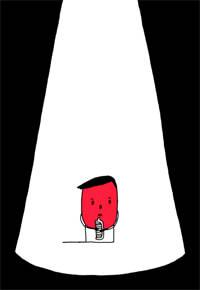
Montenegro (Dir. Luiz Stockler)
The animation screenings, as in previous years, were thematically grouped, all of which showcased some very talented and, in some instances, previously unseen animations as one would expect. Many of the selections in my three personal favourite screenings I’d been wanting to watch for a while, as well as films I know and adore and some new surprises that have left me feeling pleasantly refreshed and ready for the winter months. The festival as a whole maintained an overall atmosphere of a humble and cosy gathering of animators and film enthusiasts, this being only my second time attending the festival I felt far more at ease with both the major screenings (this time all taking place in the watershed) as well as the audience, that seemed more able to openly discuss and engage in the festival, rather than simply get in and get out.
Possibly my favourite collective screening of the whole week was the rather aptly named Animation 3: Reasons to be Cheerful. A fantastic mix of light hearted, up-tempo and generally heartwarming films which left the audience with smiles on their faces. The first of the line up was Subin Hwang’s In the Mood for Sex – at 54 secs, the super-short super short film simply depicts the act of sex using circuit diagrams, a simple idea down well.
In Montenegro a seemingly stoic man contemplates the world, his life and the loss of his hair; Dry and witty, the film gradually constructs a seemingly stream of consciousness narrative that the main character seems unaware of. With a stripped back style of animation (similer to that of Brothers McCleod – also featured in this screening with their new film 365) this offbeat animation from Royal School of Art graduate Luiz Stockler is a satisfying film in that it leaves the viewer with a palpable connection to the filmmaker’s ideas and thought process. Next in the line up was a personal highlight of this year’s edition of Encounters, Benjamin Arcand’s Wackatdooo. Regular readers of Skwigly will be aware of my fondness for the Cartoon Modern style, however the classic look of this short combined with a more modern and distinctly John K approach (albeit massively restrained) brings together a lot of great cartoon essentials. The title’s origin – referring to the behaviour of an outrageous or fanatical person – perfectly encapsulates the tone of the short, in which a cat with ultimate distain for the drudgery of working life decides to cut loose. With a dark edge this film is driven along rapidly by an upbeat soundtrack and equally quick-paced animation style.
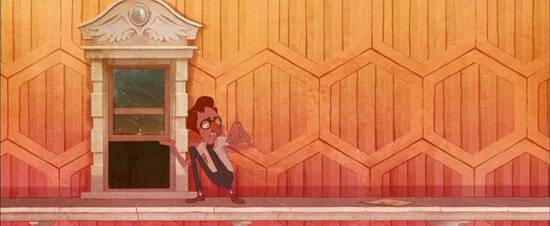
The Ledge End of Phil (from Accounting) (Dir. Paul O’Muiris)
The Ledge End of Phil (from Accounting) by Paul O’Muris was a short film I had been waiting to see for a while and was not disappointed. Despite being created at the fantastic Cartoon Saloon in Ireland, the art of this film had a far more distinctly French flavour to it, with similarities to the great master of hand-drawn animation Sylvain Chomet. The story follows a typical pen pusher as he is pushed to his limits by a ditzy seagull, ultimately conceding that there is more to life then being the employee of the month! The colour palette, line style and overall look of this film is something to be watched over and over again, dissected and studied in all its minutiae.
Impostor was another favourite form this year’s crop of new films, created at the wonderful Helium Films in Switzerland, (who represented a lot of the talented contributions front the Swiss Focus at last year’s Encounters). Created by Elie Chapuisthis, it’s yet another dark comedy from the brooding country of chocolate and wooden creatures, wherein we see a deer take the place of a human man and integrate himself into family life, bringing together a unique style of puppet animation and intriguing, adult twist on a fairy-like tale.
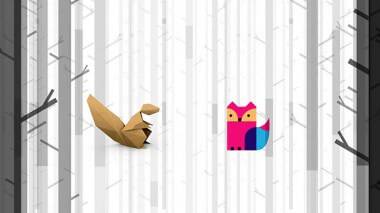
The Missing Scarf (Dir. Eoin Duffy)
Joe Blaxland’s film Technical Hitch, while not hugely original in terms of concept (the stop-motion film about stop-motion, almost a rite of passage that every animator will create at some point in homage to the difficulties and challenges when learning or creating animation) is wonderfully crafted and perfectly timed for comic affect, perhaps earning the biggest audience response in both its original screening and accidental second screening the next day. This truly exceptional selection of very few misses ended on a spectacular high note with Eoin Duffy’s The Missing Scarf, a film about a wise squirrel on an increasingly existential journey to find his scarf. Conveying commonplace human worries through minimally-designed woodland creatures, the dry humour is carried in now small way by the incandescent and loveable George Takei; Any film would struggle to be anything but completely charming with voice talent like his.
The next screening took a dark turn with the aptly named Animation 4: Fear and Loathing. It’s also interesting to note the sheer volume of quality stop motion films present in the screening, it being the kind of knowingly uncanny medium well-suited to slightly macabre tales of pain, unease and sorrow. Beginning with The Palace by John Eyre and Robin Heap, this dystopian view of a crumpling and decaying city portrays one young man’s fight for survival against a mysterious shadowy creature as his high-rise home crumbles around him. A fantastic display of stop motion acrobatics, with a melodic and haunting sound track by Chris Roe.
Settling is a distinctly more upbeat and tongue-in-cheek approach to the thriller. A killer snowman and a Christmassey overtone make this an enjoyable watch, clearly created by Emma McCann out of sheer enjoyment while tapping into a tradition of wordless storytelling stop-motion does so well.
Simulacra (Dir. Ivana Bošnjak/Thomas Johnson) is a lovely example of Eastern European storytelling and puppet building. This visibly handcrafted film, set in a nightmarish mirror maze sees both the wandering protagonist and audience begin to question which image is real. The film could perhaps have benefited from sharper editing in the final shot, but as a viewer you can’t help but marvel at how well hidden the rigs and technical processes are with so many mirrors.
Lily Fang’s RCA film The Thing Under the Tree benefits from excellent puppet design and entrancing sets, though a major downfall is the rather lacklustre voice acting and poor sound design. The film may have benefited from either more consideration with its casting or perhaps even being completely silent to allow its beguiling visual style and design speak for itself.
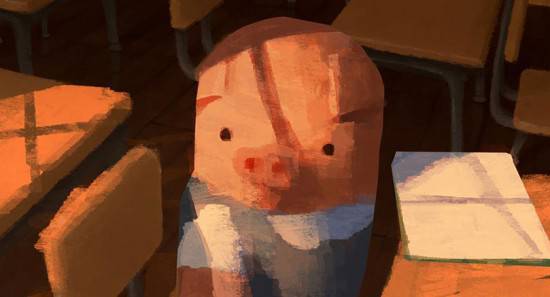
The Dam Keeper (Dir. Robert Kondo/Dice Tsutsumi)
Another from my own list of ‘must-see’s was the whimsical The Dam Keeper by ex-Pixar creatives Robert Kondo and Dice Tsutsumi, this film has been picking up accolades across the world, and it is easy to see why. This simply beautiful animation brings together digital painting techniques with adorable character design, reminiscent of Richard Scarry’s Busytown creatures. A tale of bullying, choice and ultimately friendship, it is able to move past it’s perceivably twee exterior with astounding colour and light techniques and a true overtone of sincerity in its story. The film illustrates the abilities of today’s animators and brings to life the detail and warmth of concept art we all know and love. If only more features could look like this.
Animation 5: Love, Loss and Loneliness was something of a star-studded screening, all in all. Fresh from being shown at Edinburgh earlier this year, Two Films About Loneliness by William Bishop-Stephens and Christopher Eales was another essential watch, a creative use of split-screen filmmaking and perfect example of the virtues of collaboration.
Åsa Lucander’s Lost Property, created at 12foot6 studio in London, fitted perfectly into the screening’s tagline, as it detailed the love between a couple, and how the loss of memories can ultimately lead to loneliness. You can read more about the film in the interview conducted with Åsa and animator Marc Moynham here. The painstaking digital painting technique was new to both the studio and director alike, but the attention to detail and beautiful use of colour and lighting was not lost on this animator full ordinance.
Mr. Plastimime, created by well known director Daniel Greaves, makes fantastic use of the claymation medium, as we watch a mime artist trying to make ends meet in an era where physical comedy is at a loss. As the film continuous the attributes of plasticine are used to great effect within the characters dynamic performance.
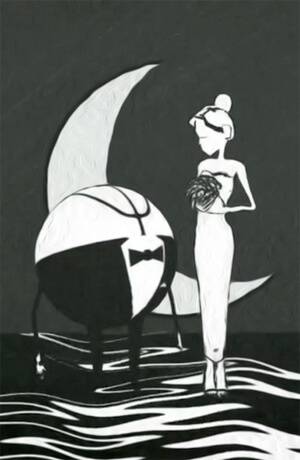
Love in the Time of March Madness
(Dir. Melissa Johnson/Robert Zambrano)
After the fantastic success of both I Am Tom Moody and The Making of Long Bird the talented due of Ainslie Henderson and Will Anderson bring us the highly anticipated Monkey Love Experiments. The audience fell in love with Gandhi, a young monkey who is led to believe that he’s destined for space, based on the real experiments by psychologist Harry Harlow who conducted experiments by the same name, to study maternal separation and dependance behaviour. The film is designed to pull on the heart strings, a real skill that these two film makers have in spades. The character and a soul in the puppet leads you to believe that, if you were able to hold it in your hands, it would actually feel warmth and have a heart beat.
Love in the Time of March Madness was a brilliant film that made full use of typography, rhythmic narration and the obvious charm of the film’s writer Melissa Johnson. A biographical animation that shines light on the difficulties of dating and life for a tall woman in today’s world, both witty and thoughtful this high-impact black and white film is a beautiful example of dynamic writing and creative use of animation coming together to entertain and enlighten an audience.
It goes without saying that Marilyn Myller by Mikey Please never fails to get a great reaction from the audience, and after been screened across the world it’s finally made its way to Encounters, to much of the audience’s delight, judging by its response.
Wrapping up these particularly strong screenings was Disney veteran Glen Keane’s new undertaking with Google, the UK premiere of the theatrical incarnation of Duet, a stunning piece of animation that brings together the classic hand-drawn style of yesteryear with the up-to-the-minute technology developed by Google. This film not only strives to bring animation forward but perfectly encapsulates the overall theme of this years Encounters festival: looking back to look forward.

